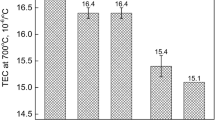Conclusions
-
1.
The addition of 5% Cr to Fe−Ni−Ti alloys lowers Ms, which substantially broadens the temperature range for aging of the alloys without danger of α phase being formed or of heterogeneous decomposition in grain boundaries.
-
2.
The strength characteristics of the Fe−Ni−Cr−Ti alloys resulting from aging are 40–60% higher than for similar alloys without chromium, with no change of the ductility in either case.
-
3.
The combination of aging and plastic deformation strengthens Fe−Ni−Cr−Ti alloys more than the alloys without chromium. With optima conditions of the combined treatment it is possible to obtain high strength characteristics for Fe−Ni−Cr−Ti alloys (σb = 135−165 kg/mm2, σ0.2 = 125−145 kg/mm2), without formation of ferromagnetic phase.
-
4.
The elongation of Fe−Ni−Cr−Ti alloys after the combined thermomechanical treatment is considerably lower than for similar alloys without chromium, which is due to the absence of the γ»α transformation during tensile tests.
Similar content being viewed by others
Literature cited
K. A. Malyshev and A. I. Uvarov, "Increase in strength during aging of austenitic steels", Metal. i Term. Obrabotka Metal., 7, 52–55 (1971).
Additional information
Institute of Physics of Metals, Academy of Sciences of the USSR. Translated from Metallovedenie i Termicheskaya Obrabotka Metallov, No. 11, pp. 11–16, November, 1974.
Rights and permissions
About this article
Cite this article
Malyshev, K.A., Uvarov, A.I. Mechanical properties of N27T3 alloys with chromium. Met Sci Heat Treat 16, 916–919 (1974). https://doi.org/10.1007/BF00663794
Issue Date:
DOI: https://doi.org/10.1007/BF00663794




